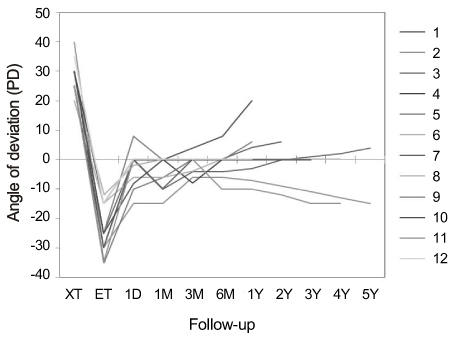J Korean Ophthalmol Soc.
2012 Mar;53(3):446-451.
Clinical Manifestation after Surgical Correction of Consecutive Esotropia
- Affiliations
-
- 1Department of Ophthalmology, Chungbuk National University College of Medicine, Chungbuk National University Medical Research Institute, Cheongju, Korea. mychoi@chungbuk.ac.kr
Abstract
- PURPOSE
To report the clinical outcome of patients with consecutive esotropia (ET) in the pre- and post-operative periods and at the last postoperative visit.
METHODS
The present study included 12 patients who underwent surgery for the correction of consecutive ET. The angle of deviation, duration of consecutive ET, and surgical and non-surgical methods for correction of consecutive ET were investigated. The sensory status was evaluated before the surgery of exotropia (XT), during consecutive ET and after the surgery for consecutive ET.
RESULTS
The average angle of deviation before the surgery of XT was 27.5 PD and 3 patients had lateral incomittancy. Alternate occlusion treatment was performed in all patients, and 10 patients wore Fresnel prisms. The average angle of deviation of consecutive ET was 24.3 PD. After an average of 30 months postoperative consecutive ET, 9 patients were orthotropic or had deviation within 8 PD, 2 patients had 15 PD ET, and 1 patient had 20 PD XT. There were 3 patients whose stereopsis was aggravated and 1 patient had poorer fusion during consecutive ET, and recovered after the surgery for consecutive ET. No patients had a decrease in visual acuity.
CONCLUSIONS
As a result of alternate occlusion and Fresnel prisms during consecutive ET after surgery of XT, the incidence of aggravation in binocularity was low, and the cases with aggravated binocularity were recovered after surgical correction of consecutive ET. The surgical success rate was 75% in consecutive ET.
Keyword
Figure
Reference
-
1. Paik HJ, Cho YA. Recession of the lateral recti in intermittent exotropia evaluation of the amount of immediate postoperative deviation. J Korean Ophthalmol Soc. 1990. 31:1445–1450.2. Park YH, Kim MM. Surgical results of intermittent exotropia. J Korean Ophthalmol Soc. 1989. 30:969–974.3. Dunlap EA. Overcorrections in horizontal strabismus surgery. Symposium on Strabismus. Transactions of the neworleans academy of ophthalmology. 1971. St Louis: Mosby-Year Book;255.4. Cho YA, Kang SM, Roh GH. Asymmetric bilateral lateral recti recession in intermittent exotropia. J Korean Ophthalmol Soc. 1999. 40:544–549.5. Hardesty HH, Boynton JR, Keenan JP. Treatment of intermittent exotropia. Arch Ophthalmol. 1978. 96:268–274.6. Kim JH, Hwang JM. Initial overcorrection of 20 delta or more after surgery of exotropia. J Korean Ophthalmol Soc. 2003. 44:121–127.7. Shin YJ, Chang BL. The clinical outcome of the consecutive esotropia after surgical correction. J Korean Ophthalmol Soc. 2003. 44:2085–2090.8. Lew H, Lee JB, Han SH, Park HS. Clinical evaluation on the consecutive esotropia after exotropia surgery. J Korean Ophthalmol Soc. 1999. 40:3482–3490.9. Roh YB, Lee JR. Consecutive esotropia after surgery for intermittent exotropia. J Korean Ophthalmol Soc. 1998. 39:388–392.10. Lee JH, Lee SY, Lee YC. The effect of lateral rectus muscle advancement in consecutive esotropia after bilateral rectus muscle recession. J Korean Ophthalmol Soc. 2008. 49:1801–1806.11. Lee SY, Lee YC. Comparison of surgical results by initial postoperative alignment following bilateral lateral rectus recession and unilateral lateral rectus recession-medial rectus resection in intermittent exotropes. J Korean Ophthalmol Soc. 1999. 40:2604–2610.12. Son AN, Park SC, Lee WR. Clinical study of consecutive esotropia. J Korean Ophthalmol Soc. 1990. 31:1328–1334.13. Kim HS, Suh YW, Kim SH, Cho YA. Consecutive esotropia in intermittent exotropia patients with immediate postoperative overcorrection more than 17 prism diopters. Korean J Ophthalmol. 2007. 21:155–158.14. Lee JM, Shin SY. Recovery pattern of overcorrection after intermittent exotropia surgery. J Korean Ophthalmol Soc. 2005. 46:821–826.15. You IC, Yoon KC, Park YG. Assessment of esotropia more than 10PD after surgery of intermittent exotropia. J Korean Ophthalmol Soc. 2003. 44:2278–2284.16. Raab EL. Rosenbaum AL, Santiago AP, editors. Difficult esotropia entities: principles of management. Clinical Strabismus Management. 1999. Philadelphia: W.B. Saunders company;chap. 9.17. Kim YH, Choi MY. The effect of Fresnel prism treatment in consecutive esotropia. J Korean Ophthalmol Soc. 2006. 47:1623–1629.18. Kim JS, Son KH. The effect of advancement of the lateral rectus muscle on the consecutive esotropia. J Korean Ophthalmol Soc. 1995. 36:1784–1789.
- Full Text Links
- Actions
-
Cited
- CITED
-
- Close
- Share
- Similar articles
-
- The Clinical Outcome of the Consecutive Esotropia after Surgical Correction
- The Clinical Course of Consecutive Esotropia after Surgical Correction
- Spontaneous Consecutive Exotropia
- Clinical Manifestations of Delayed-onset Consecutive Esotropia after Surgical Correction of Intermittent Exotropia
- Clinical Manifestation and Surgical Outcomes of Consecutive Exotropia


